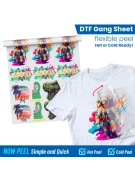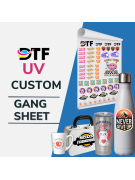How DTF Shirt Printing is Changing the Fashion Industry

Unlike traditional printing methods, DTF printing offers you a way to transfer intricate designs onto all kinds of fabrics. Plus, with this technique, you don’t have to worry about the design fading over time, or the color getting smudged when washed.
Whether for bespoke fashion collections or personalized merchandise, DTF printing is making waves in the industry. And in this article, we will discuss more about what it is, and its practical applications in custom apparel.
What is DTF Printing?
DTF printing, or Direct-to-Film printing, is a modern printing method that involves transferring designs onto fabric using a specially formulated adhesive and heat application. Unlike other techniques, which often require direct printing onto fabric, DTF uses a transfer film as an intermediary.
This process begins with printing a design onto a polyethylene terephthalate (PET) film using a dedicated DTF printer and pigment-based inks. A powder adhesive is then applied to the print, which is cured with heat.
Finally, the design is transferred to the fabric using a heat press. The result is a high-quality, durable print that retains its vibrancy and texture over time.
This technique works well with all kinds of fabric, including cotton, polyester, and blends, which is why it has gained significant traction in recent years.
How is DTF Printing Better than Other Methods?
Here’s why we believe DTF printing is superior to other alternatives:
Works with All Kinds of Fabrics
DTF printing stands out for its ability to work with various materials. Unlike sublimation, which is limited to polyester, or screen printing, which performs best on cotton, DTF effortlessly adheres to cotton, polyester, nylon, and more.
Durability
The adhesive powder used in DTF printing enhances the bond between the design and the fabric, ensuring prints resist cracking, peeling, or fading even after multiple washes.
Detail in Design and Color
DTF printing offers unmatched precision, making it ideal for intricate designs, gradients, and vibrant colors. The prints remain consistent and eye-catching, regardless of the complexity of the artwork.
Cost Efficiency
Traditional methods like screen printing become cost-prohibitive for small orders due to setup costs. DTF printing eliminates this barrier, making it an economical choice for customized or limited-edition apparel.
Eco-Friendly Approach
DTF printing uses water-based inks and avoids wastage, contributing to a more sustainable production process compared to other methods like plastisol-based screen printing.
DTF Printing and Sustainable Fashion
The fashion industry faces increasing scrutiny for its environmental impact. If you are running a business in customized shirts, having eco-friendly products can be a major selling and revenue-boosting point.
Here’s how DTF printing is a major shift in sustainable fashion:
Reduced Waste in Production
Traditional printing methods like screen printing require significant preparation, including creating screens for each color in a design. This process often leads to wasted ink and materials when designs are adjusted or discarded.
DTF printing, on the other hand, eliminates the need for these preliminary steps. Designs are printed directly onto PET film and transferred only when needed, reducing waste associated with unused screens and excess ink.
Eco-Friendly Ink Usage
DTF printing employs water-based inks, which are less harmful to the environment compared to solvent-based alternatives. These inks are free from volatile organic compounds (VOCs), ensuring safer working conditions for operators and reduced air pollution during production.
Energy Efficiency
Unlike dye sublimation and other heat-intensive methods, DTF printing operates efficiently without requiring excessive energy.
The process involves a single heat press step for transferring the design, minimizing electricity usage compared to methods that necessitate multiple curing or heating stages.
Prolonged Garment Lifespan
DTF prints are known for their durability, retaining their vibrancy even after numerous washes. This longevity reduces the frequency with which garments are discarded due to fading or damage, aligning with the principles of sustainable fashion by encouraging longer use cycles.
Customization with Minimal Resources
DTF printing’s ability to handle small runs and one-off designs without significant setup or waste aligns with the growing demand for personalized, made-to-order clothing. This reduces overproduction (that is a major issue in the fast-fashion industry), and ensures that resources are used only when there is genuine demand.
As the demand for sustainable practices grows, DTF printing is expected to evolve further with advancements in biodegradable films and inks. Research is underway to develop more eco-friendly PET film alternatives that retain the same level of performance while reducing plastic use.
Techniques Involved in DTF Printing?
Here’s how DTF printing is carried out:
Design Preparation
The process starts with creating a digital design, often using software like Adobe Illustrator or CorelDRAW. This ensures that the design is optimized for color accuracy and resolution.
Printing on PET Film
Using specialized DTF printers, the design is printed in reverse on the PET film. White ink is layered as the base to enhance the opacity and color vibrancy when transferred.
Adhesive Application
A powder adhesive is sprinkled over the wet ink. This powder acts as a bonding agent between the design and the fabric.
Heat Curing
The adhesive-coated film is cured under heat to solidify the bond. This step is crucial for ensuring the durability of the final print.
Heat Transfer
The cured film is placed on the fabric, and a heat press is used to transfer the design. The film is peeled off after cooling, leaving the design seamlessly integrated into the material.
How to Take Care of DTF Printed Shirts?
DTF shirts are cool, and offer a great value for money. However, to maintain its condition and quality, adequate care is essential. Here’s how to do it:
- Washing Guidelines: Always turn the shirt inside out before washing. Use a gentle cycle with cold water and mild detergent.
- Avoid Harsh Chemicals: Refrain from using bleach or fabric softeners, as they can degrade the adhesive layer.
- Drying Instructions: Air-dry the shirt or use a low-heat tumble dryer. High heat can weaken the print.
- Ironing Precautions: If ironing is necessary, place a cloth over the design or iron the shirt inside out. Direct heat can damage the print.
- Storage Tips: Store shirts in a cool, dry place away from direct sunlight to prevent fading.
8 Cool DTF Print Ideas for Customized Shirts
- Here are some cool DTF print ideas you can consider for your shirts:
- Pop Culture Icons: Celebrate your favorite movies, TV shows, or music artists with bold, colorful designs.
- Minimalist Quotes: Simple yet impactful typography-based designs can resonate deeply with wearers.
- Abstract Art: Create visually stunning patterns with a mix of colors and shapes.
- Team Logos: Perfect for sports teams or organizations looking to showcase their identity.
- Custom Portraits: Turn personal photos into wearable memories with precise detailing.
- Seasonal Themes: From festive designs to summer vibes, seasonal prints are always in demand.
- Interactive Designs: Incorporate QR codes or augmented reality elements for a tech-savvy touch.
- Eco-Friendly Statements: Promote sustainability with earth-inspired motifs and slogans.
What to Look for in a Professional DTF Printer?
Choosing the right DTF printing service is crucial for quality results. Here are some factors to consider:
- Quality of Equipment: Ensure the printer uses advanced DTF machinery and high-quality PET films.
- Ink and Adhesive Standards: Look for services that use eco-friendly, pigment-based inks and durable adhesives.
- Customization Options: The service should offer a wide range of customization options, including color matching and fabric compatibility.
- Turnaround Time: Quick and reliable delivery timelines are essential, especially for time-sensitive projects.
- Portfolio and Reviews: Check previous work and customer testimonials to assess the printer’s reliability and quality.
- Pricing Transparency: Ensure there are no hidden charges and that pricing aligns with the level of service, as well as your budget.
Contact Us for DTF Prints!
DTF Transfers Now stands out for its commitment to providing high-quality DTF printing services tailored to your needs. Our expert team utilizes cutting-edge technology to produce vibrant, durable, and precise designs on various fabrics.
With fast turnaround times and competitive pricing, we ensure your projects are delivered on schedule and within budget. Our customer-focused approach guarantees a seamless experience, from design to final product.
For more information, contact us now!
Frequently Asked Questions
Why is DTF printing better than sublimation?
Sublimation is a cool and commonly used technique where you digitally print a design onto a material by using heat and pressure, which turns the ink into a gas.
While sublimation is limited to polyester fabrics and light colors, DTF printing is compatible with a broader range of materials and colors. Additionally, DTF prints are more durable and less prone to fading. Hence, why DTF is a preferred choice.
Why should you get professional DTF printing services for customized shirts?
Professional services ensure access to advanced equipment and high-quality materials, resulting in superior print quality. Additionally, experienced providers can easily handle complex designs with precision, which saves time, and ensures better results.





Leave a comment